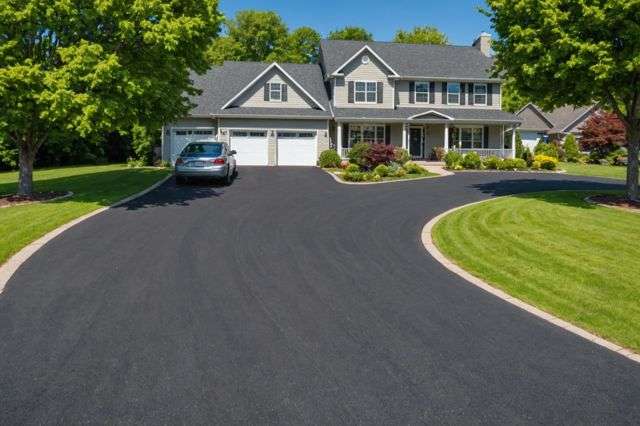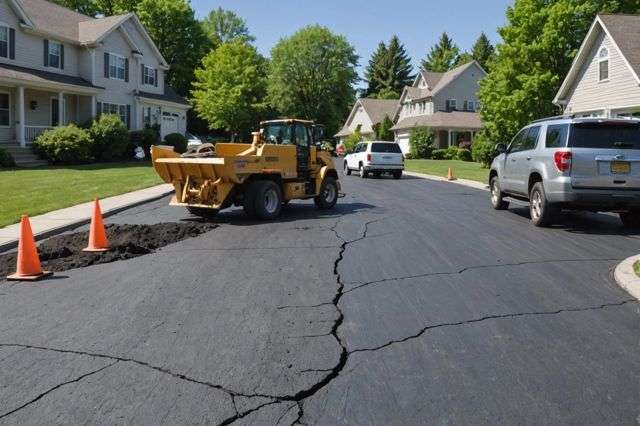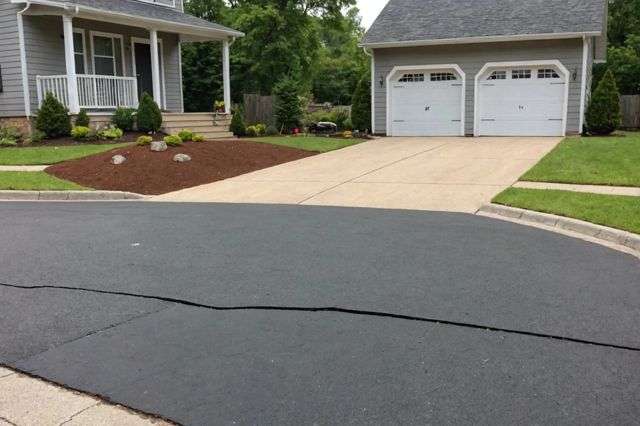
Asphalt Resurfacing vs. Full Replacement

Asphalt resurfacing is cost-effective and suitable for driveways with minor wear, adding up to 15 years to the pavement’s life without replacing the entire surface. Full replacement, however, is necessary for driveways with severe damage or structural failures, ensuring longevity of up to 20 years with a new foundation and asphalt layer.
Introduction to Asphalt Solutions
Proper asphalt maintenance is key to extending the life of your pavement. It involves regular checks and quick action to fix any problems like cracks or wear. Here are some tips to keep your asphalt in top shape:
- Initial Care: For the first few weeks after your asphalt is laid, avoid parking on it for long periods to prevent damage.
- Chemical Spills: Keep chemicals and gas off your driveway to prevent damage. Consider using fuel-resistant asphalt for better durability.
- Crack Filling: Seal any cracks or potholes quickly to stop water from getting in and causing more damage.
- Heat Caution: Try not to park on your asphalt in very hot weather as it can lead to cracking.
- Sealcoating: Apply a sealant every 2-3 years to protect against the weather and keep your driveway looking new.
- Drainage: Make sure you have good drainage to avoid water damage.
- Edge Protection: Avoid driving or parking on the edges of the driveway to prevent cracks.
Regularly maintaining your asphalt not only keeps it looking good but also makes it safer and extends its lifespan up to 20 years. Simple actions like cleaning, filling cracks, and sealing can make a big difference.

What is Asphalt Resurfacing?
Asphalt resurfacing is a method used to renew the top layer of an asphalt pavement without replacing the entire surface. It’s recommended when the foundation is still in good condition but the surface shows signs of wear and aging. Here are the steps involved in asphalt resurfacing:
- Assessment: The existing pavement is inspected for damage. Only surfaces with stable bases are suitable for resurfacing.
- Cleaning: The surface is cleaned to remove debris and ensure proper adhesion of the new asphalt.
- Repairing: Any cracks or holes are filled to prevent moisture from seeping into the base.
- Applying Tack Coat: A tack coat is sprayed to help the new layer of asphalt adhere to the old one.
- Resurfacing: A new layer of asphalt is applied and compacted to create a smooth, durable surface.
Benefits of asphalt resurfacing include:
- Cost-Effectiveness: It is less expensive than full pavement replacement.
- Time Efficiency: The process is quicker, minimizing disruption.
- Extending Pavement Life: It can add years to the pavement’s lifespan by protecting the base from further damage.
- Improved Safety and Aesthetics: Resurfacing smooths out the surface, enhancing both the look and safety of the pavement.
When to Choose Full Asphalt Replacement
Choosing to replace your entire asphalt is a big decision and should be considered under specific conditions. Here are some scenarios where full replacement is necessary:
- Irreparable Damage: When the asphalt shows extensive damage like deep cracks, large potholes, or areas where the surface has completely failed, repairs might not be enough to restore its integrity and functionality.
- Aging Asphalt: If the asphalt is nearing the end of its expected lifespan, which can be up to 20 years with proper maintenance, replacing it might be more cost-effective than frequent repairs.
- Foundation Issues: Should the base layer of the driveway be unstable or improperly constructed, resurfacing won’t address these deeper, structural problems. A full replacement allows for the correction of these foundational issues.
- Severe Weather Impact: In areas subjected to extreme weather conditions, the asphalt might degrade faster. If maintenance has not prevented weather-related damages, replacement might be necessary to ensure durability.
Considering these factors will guide you in deciding whether a full asphalt replacement is the best choice for your property. This approach not only addresses all existing and potential issues but also enhances the long-term value and use of the pavement.

Comparative Analysis: Costs and Longevity
When deciding between asphalt resurfacing and full replacement, both the costs and longevity are essential factors to consider. Resurfacing can be a cost-effective option for driveways that are structurally sound but showing surface wear. It involves applying a new layer of asphalt over the existing one, which can significantly extend the life of the driveway at a lower cost compared to full replacement.
- Costs: Resurfacing requires less material and labor, making it less expensive than full replacement. It is ideal for driveways with minor wear and no major structural issues.
- Longevity: Properly maintained, resurfaced asphalt can last an additional 8 to 15 years. Regular maintenance such as sealcoating and crack filling is crucial to maximize lifespan.
In contrast, a full replacement involves removing the existing driveway and laying down a new foundation and asphalt layer. This option is necessary when the driveway has severe structural failures such as deep cracks, potholes, or foundation issues.
- Costs: Full replacement is more costly due to the extensive labor and materials required. It is a significant investment but necessary for severely damaged driveways.
- Longevity: A completely new asphalt driveway, if well-constructed and maintained, can last up to 20 years. Regular maintenance, avoiding heavy loads, and using proper drainage systems contribute to its longevity.
Homeowners and property developers should weigh these factors based on the current condition of the driveway and long-term cost implications. Regular maintenance plays a vital role in extending the lifespan of both resurfaced and newly replaced driveways.

FAQ
What is asphalt resurfacing and when should I consider it?
Asphalt resurfacing involves renewing the top layer of an asphalt pavement. It’s suitable when the foundation is in good condition but the surface shows signs of wear and aging. This method is cost-effective, time-efficient, extends pavement life, and improves safety and aesthetics.
What are the steps involved in asphalt resurfacing?
The asphalt resurfacing process includes assessing the existing pavement for damage, cleaning the surface, repairing any damages like cracks or holes, applying a tack coat to ensure proper adhesion, and then resurfacing with a new layer of asphalt which is then compacted.
When is full asphalt replacement necessary?
Full replacement is recommended when there is extensive damage such as deep cracks and large potholes, when the asphalt is near the end of its lifespan, or if there are foundation issues. It’s also necessary in cases where severe weather has caused irreparable damage.
What are the benefits of full asphalt replacement?
Replacing the entire asphalt provides a new, stable foundation and surface which addresses all existing and potential issues. It enhances the long-term value and usability of the pavement and can last up to 20 years with proper maintenance.
How do the costs and longevity of asphalt resurfacing compare to full replacement?
Asphalt resurfacing is less expensive as it requires less material and labor and is ideal for minor wear without major structural issues. It can extend the pavement life by an additional 8 to 15 years. Full replacement involves more labor and materials but is necessary for severely damaged driveways and can last up to 20 years.
What regular maintenance is recommended for asphalt pavements?
Regular maintenance includes avoiding long periods of parking initially, keeping chemicals and gas off the surface, filling any cracks or potholes promptly, not parking on the asphalt in very hot weather, applying a sealant every 2-3 years, ensuring good drainage, and protecting the edges from being driven on or parked over. Regular maintenance can extend the life of the pavement up to 20 years with these practices.
What should I consider when choosing between resurfacing and full asphalt replacement?
Consider the current condition of the driveway, the extent of any damage, underlying foundation issues, and the impact of local weather conditions. Assessing the long-term cost implications and expected longevity based on these factors will guide the decision-making process.
